|
|
1.Turn up the floor carpet under the brake pedal.
|
|
|
2.Remove the stop lamp switch (Refer to  ). ).
|
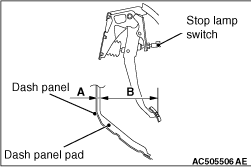
|
3.Use a needle or similar tool to measure the dimension A in the figure (distance from the
dash panel pad surface to the dash panel).
4.Measure the dimension B in the figure (distance from the pedal pad surface to the
dash panel pad surface).
5.Make sure that the total of the dimensions A and B measured in Steps 3 and 4 (brake
pedal height) is within the standard value.
Standard value (A+B): 219.8 - 227.8 mm
|
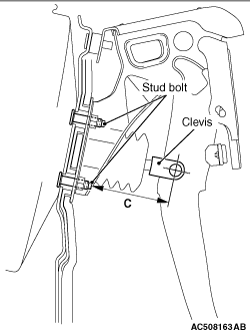
|
6.When the brake pedal height is not within the standard value, inspect the brake pedal
in the following procedure.
(1)
Remove the brake pedal assembly (Refer to  ). ).
(2)
Check the removed brake pedal assembly for distortion, and replace it when deformed
(Refer to  ). ).
(3)
Install the brake pedal assembly (Refer to  ). ).
|
|
| note |
When installing, compress the dash panel pad.
|
|
(4)
Measure the brake pedal height again, and make sure that it is within the standard value
(A+B).
When the measured value is not within the standard value, measure the
dimension C in the figure (distance from the stud bolt end to the clevis hole centre), and make
sure it is within the standard value (C).
Standard value (C): 75.8 - 80.2 mm
(5)
When the measured value is not within the standard value (C), replace the brake booster
(Refer to  ). ).
|
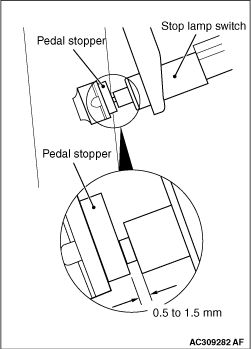
|
7.After checking the brake pedal height, install the stop lamp switch in the following procedure:
(1)
Screw in the stop lamp switch until its thread contacts the pedal stopper, then turn
the switch approximately one eighth of a clockwise turn to fix it. While doing this, pull and
hold the brake pedal by hand.
(2)
Check that the clearance between the stop lamp switch and the pedal stopper is as
shown in the figure.
(3)
Connect the stop lamp switch connector.
|
|
| note |
Make sure that the stop lamp is not illuminated when the brake pedal is not depressed.
|
|
8.Check the shift lock mechanism (Refer to GROUP 23A - On-vehicle Service,
Shift Lock Mechanism Check  ). ).
9.Recover the floor carpet under the brake pedal.
|
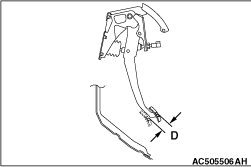
|
1.With the engine stopped, depress the brake pedal 2 or 3 times to release the vacuum in
the brake booster. Then, press the brake pedal with your finger and check if the pedal stroke
until the pedal becomes heavy (play) is within the standard value.
Standard value (D): 3 - 8 mm
2.When the brake pedal play is not within the standard value, check the brake pedal-to-clevis
pin looseness, clevis pin-to-booster operating rod looseness, brake pedal height, and stop lamp
switch position, and adjust or replace as necessary.
|
|
|
1.Turn up the floor carpet under the brake pedal.
|
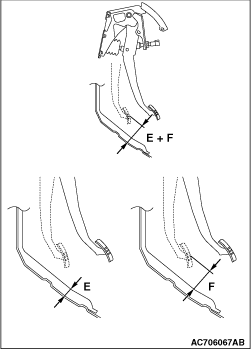
|
2.Use a needle or similar tool to measure the dimension E in the figure (distance from the
dash panel pad surface to the dash panel).
3.Start the engine and depress the brake pedal with approximately 500 N, and measure
the dimension F in the figure (distance from the pedal pad surface to the dash panel pad surface).
4.Make sure that the total of the dimensions E and F measured in Steps 2 and 3 (brake
pedal to dash panel clearance) is within the standard value.
Standard value (E+F): 85 mm or more
5.When the clearance is not within the standard value, check for air in the brake line
and thickness of the disc brake pad, and correct or replace as necessary.
6.Recover the floor carpet under the brake pedal.
|
 ).
). ).
).
 ).
).
